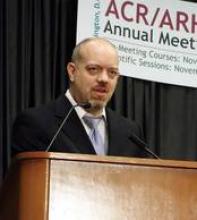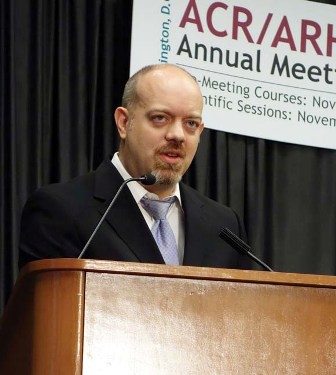User login
WASHINGTON – Do you Twitter?
That was the question posed by Dr. Christopher Collins at the annual meeting of the American College of Rheumatology, and it wasn’t an idle query. According to Dr. Collins, the social media site and other mobile, Web-based media tools are poised to become the next big thing in rheumatology education.
"The next generation of rheumatology fellows has already embraced mobile technology as an important aspect of not only everyday life, but as a tool to augment their education," said Dr. Collins, director of the fellowship program for the division of rheumatology at Washington (D.C.) Hospital.
"Social media outlets such as Twitter provide a means for interactions which are not limited by geography, and provide a potential means to enhance the education experience."
At the meeting, Dr. Collins presented proof of concept: His Twitter feed, @RheumPearls, offers a (roughly) daily, 140-character rheumatology "pearl of wisdom" on topics including arthritis, lupus, and gout.
The development of his feed was supported by a grant from the ACR’s Rheumatology Research Foundation, awarded to Dr. Collins in 2010. The Clinician Scholar Educator award aims to further the development of new teaching strategies in rheumatology, according to the ACR’s website.
Founded in March 2011, Dr. Collins’s Twitter feed has nearly 1,000 followers from 57 different countries, with 434 tweets posted at the time of his presentation.
In an analysis of his first 100 followers, Dr. Collins calculated that 25% were physicians (61% of whom were rheumatologists), 23% were patients with self-identified rheumatic conditions (especially lupus and rheumatoid arthritis), 18% were professional medical organizations, and 11% were medical trainees, including medical students, residents, and fellows.
The remainder were unidentified or affiliated with the pharmaceutical industry.
A website Dr. Collins created to complement the Twitter feed has also garnered attention, with 8,125 page views and 6,500 unique visitors from 102 different countries at the time of his presentation.
According to Dr. Collins, his Twitter feed represents just one of the myriad ways in which the social media site, and sites like it, could be used to educate and inform students as well as practitioners of rheumatology.
For example, he pointed to the ways in which Twitter is already used at the ACR’s annual meeting.
"With the use of hashtags, tweets can be ‘tagged’ for searching relevant topics," said Dr. Collins in an e-mail interview.
"During the ACR, searching ‘#ACR2012’ revealed all the relevant tweets being posted about the conference for participants to follow."
In the future, "after a presentation on a particular topic has ended, discussion points can be posted to Twitter for comment by the participants," he said.
In addition, "the participants can continue to be part of the discussion even after the original presentation has ended, as long as they have access to the Internet (as most do with their mobile devices)," Dr. Collins noted.
The technology can also foster more individualized education, even as it reaches out readily to the vast network of Twitter users.
"A mentor who is willing to engage their learners through social media like Twitter can increase their availability to students and augment interactions through direct conversations, and provide links to literature, etc.," he said.
"In addition to purely informative educational Twitter feeds like mine, I see Twitter as having the potential to engage a global population interested in rheumatology and rheumatology education through live interactive discussions."
Dr. Collins disclosed being on a speakers bureau for GlaxoSmithKline and Abbott Laboratories. He stated that he had nothing to disclose relevant to the development and implementation of RheumPearls.
WASHINGTON – Do you Twitter?
That was the question posed by Dr. Christopher Collins at the annual meeting of the American College of Rheumatology, and it wasn’t an idle query. According to Dr. Collins, the social media site and other mobile, Web-based media tools are poised to become the next big thing in rheumatology education.
"The next generation of rheumatology fellows has already embraced mobile technology as an important aspect of not only everyday life, but as a tool to augment their education," said Dr. Collins, director of the fellowship program for the division of rheumatology at Washington (D.C.) Hospital.
"Social media outlets such as Twitter provide a means for interactions which are not limited by geography, and provide a potential means to enhance the education experience."
At the meeting, Dr. Collins presented proof of concept: His Twitter feed, @RheumPearls, offers a (roughly) daily, 140-character rheumatology "pearl of wisdom" on topics including arthritis, lupus, and gout.
The development of his feed was supported by a grant from the ACR’s Rheumatology Research Foundation, awarded to Dr. Collins in 2010. The Clinician Scholar Educator award aims to further the development of new teaching strategies in rheumatology, according to the ACR’s website.
Founded in March 2011, Dr. Collins’s Twitter feed has nearly 1,000 followers from 57 different countries, with 434 tweets posted at the time of his presentation.
In an analysis of his first 100 followers, Dr. Collins calculated that 25% were physicians (61% of whom were rheumatologists), 23% were patients with self-identified rheumatic conditions (especially lupus and rheumatoid arthritis), 18% were professional medical organizations, and 11% were medical trainees, including medical students, residents, and fellows.
The remainder were unidentified or affiliated with the pharmaceutical industry.
A website Dr. Collins created to complement the Twitter feed has also garnered attention, with 8,125 page views and 6,500 unique visitors from 102 different countries at the time of his presentation.
According to Dr. Collins, his Twitter feed represents just one of the myriad ways in which the social media site, and sites like it, could be used to educate and inform students as well as practitioners of rheumatology.
For example, he pointed to the ways in which Twitter is already used at the ACR’s annual meeting.
"With the use of hashtags, tweets can be ‘tagged’ for searching relevant topics," said Dr. Collins in an e-mail interview.
"During the ACR, searching ‘#ACR2012’ revealed all the relevant tweets being posted about the conference for participants to follow."
In the future, "after a presentation on a particular topic has ended, discussion points can be posted to Twitter for comment by the participants," he said.
In addition, "the participants can continue to be part of the discussion even after the original presentation has ended, as long as they have access to the Internet (as most do with their mobile devices)," Dr. Collins noted.
The technology can also foster more individualized education, even as it reaches out readily to the vast network of Twitter users.
"A mentor who is willing to engage their learners through social media like Twitter can increase their availability to students and augment interactions through direct conversations, and provide links to literature, etc.," he said.
"In addition to purely informative educational Twitter feeds like mine, I see Twitter as having the potential to engage a global population interested in rheumatology and rheumatology education through live interactive discussions."
Dr. Collins disclosed being on a speakers bureau for GlaxoSmithKline and Abbott Laboratories. He stated that he had nothing to disclose relevant to the development and implementation of RheumPearls.
WASHINGTON – Do you Twitter?
That was the question posed by Dr. Christopher Collins at the annual meeting of the American College of Rheumatology, and it wasn’t an idle query. According to Dr. Collins, the social media site and other mobile, Web-based media tools are poised to become the next big thing in rheumatology education.
"The next generation of rheumatology fellows has already embraced mobile technology as an important aspect of not only everyday life, but as a tool to augment their education," said Dr. Collins, director of the fellowship program for the division of rheumatology at Washington (D.C.) Hospital.
"Social media outlets such as Twitter provide a means for interactions which are not limited by geography, and provide a potential means to enhance the education experience."
At the meeting, Dr. Collins presented proof of concept: His Twitter feed, @RheumPearls, offers a (roughly) daily, 140-character rheumatology "pearl of wisdom" on topics including arthritis, lupus, and gout.
The development of his feed was supported by a grant from the ACR’s Rheumatology Research Foundation, awarded to Dr. Collins in 2010. The Clinician Scholar Educator award aims to further the development of new teaching strategies in rheumatology, according to the ACR’s website.
Founded in March 2011, Dr. Collins’s Twitter feed has nearly 1,000 followers from 57 different countries, with 434 tweets posted at the time of his presentation.
In an analysis of his first 100 followers, Dr. Collins calculated that 25% were physicians (61% of whom were rheumatologists), 23% were patients with self-identified rheumatic conditions (especially lupus and rheumatoid arthritis), 18% were professional medical organizations, and 11% were medical trainees, including medical students, residents, and fellows.
The remainder were unidentified or affiliated with the pharmaceutical industry.
A website Dr. Collins created to complement the Twitter feed has also garnered attention, with 8,125 page views and 6,500 unique visitors from 102 different countries at the time of his presentation.
According to Dr. Collins, his Twitter feed represents just one of the myriad ways in which the social media site, and sites like it, could be used to educate and inform students as well as practitioners of rheumatology.
For example, he pointed to the ways in which Twitter is already used at the ACR’s annual meeting.
"With the use of hashtags, tweets can be ‘tagged’ for searching relevant topics," said Dr. Collins in an e-mail interview.
"During the ACR, searching ‘#ACR2012’ revealed all the relevant tweets being posted about the conference for participants to follow."
In the future, "after a presentation on a particular topic has ended, discussion points can be posted to Twitter for comment by the participants," he said.
In addition, "the participants can continue to be part of the discussion even after the original presentation has ended, as long as they have access to the Internet (as most do with their mobile devices)," Dr. Collins noted.
The technology can also foster more individualized education, even as it reaches out readily to the vast network of Twitter users.
"A mentor who is willing to engage their learners through social media like Twitter can increase their availability to students and augment interactions through direct conversations, and provide links to literature, etc.," he said.
"In addition to purely informative educational Twitter feeds like mine, I see Twitter as having the potential to engage a global population interested in rheumatology and rheumatology education through live interactive discussions."
Dr. Collins disclosed being on a speakers bureau for GlaxoSmithKline and Abbott Laboratories. He stated that he had nothing to disclose relevant to the development and implementation of RheumPearls.
EXPERT ANALYSIS FROM THE ANNUAL MEETING OF THE AMERICAN COLLEGE OF RHEUMATOLOGY

